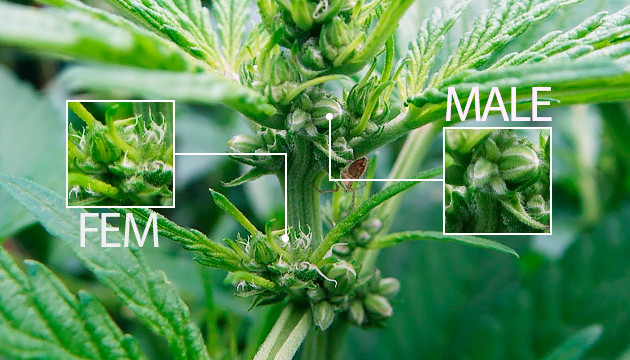Appearance of Marijuana Plant
In terms of appearance, a marijuana plant exhibits numerous structures that are commonly found in typical flowering plants. It grows on slender and elongated stems, accompanied by its well-known fan leaves that extend outward from specific points known as nodes.
However, it is in the realm of its flowers, or buds, where the cannabis plant truly distinguishes itself. These buds showcase remarkable characteristics that are both unique and intricate. They feature fiery orange hairs, sugary crystals, and substantial buds enveloped by delicate leaves, making cannabis instantly recognizable and visually captivating.
Components of the Cannabis Plant

Image source: (https://dutch-passion.com/en/blog/cannabis-plants-anatomy-from-seed-to-trichomes-n1094)
Cannabis Roots: The roots of a cannabis plant extend downwards from the main stem into the soil. In the case of germination from a seed, the primary root is referred to as the “taproot.” Roots play a crucial role as the lifelines of the plant, drawing in water and oxygen to support healthy and robust growth.
To enhance root systems, beneficial fungus called mycorrhizae can be introduced into the soil.
Marijuana Plant Stem: The primary stem, also known as the stalk, emerges vertically from the root system and provides structural support to all lateral branches. The stem is responsible for giving the plant stability and shape.
In many cases, growers opt to perform “topping” by cutting off the stem after approximately five nodes. This technique encourages lateral growth, leading to the development of more bud sites.
Branches: Branches sprout from the main stem and provide support for fan leaves and buds. Growers often employ training methods that involve topping branches to stimulate the growth of additional bud sites.
Node: A node denotes the specific point at which a branch emerges from either the main stem or another branch. Some nodes may bear fan leaves and buds, although not all nodes necessarily do.
When determining the sex of a cannabis plant, pre-flowers, which are the initial signs of male or female sex organs, become visible at the nodes.
The gap between nodes is referred to as “internodal spacing” and offers insights into the potential height of the plant, indicating whether it will grow tall or remain shorter in stature.
Fan Leaves: Fan leaves are the prominent, large leaves of the cannabis plant. They have a distinct shape and are responsible for capturing light for the plant’s photosynthesis process. Typically, fan leaves contain minimal to no resin and are often removed during the trimming process.
Sugar Leaves: Sugar leaves are the small leaves coated with resin that surround the buds of the cannabis plant. These resinous leaves are often referred to as “trim” and are saved during harvest. They can be utilized in various cannabis products such as pre-rolls and extracts.
Flowers: Also known as buds, the flowers of the cannabis plant are the desired end product. These flowering structures contain the cannabinoids and terpenes responsible for the psychoactive or therapeutic effects of cannabis. Flowers exclusively grow on female cannabis plants and must be properly dried before consumption.
Cola: A cola, also known as a “bud site,” refers to a cluster of buds that grow closely together. While smaller colas can develop along the lower branches, the main cola, also called the apical bud, forms at the top of the plant.
Bract and Calyx: A bract is a leaf-like structure that encloses the female reproductive parts of the cannabis plant. These green, tear-shaped bracts are heavily coated in resin glands, which contain the highest concentration of cannabinoids among all parts of the plant. The calyx, on the other hand, is a translucent layer covering the ovule at the base of a flower.
Stigma and Pistil: The pistil is the female reproductive organ within a flower, and the vibrant, hair-like strands of the pistil are known as stigmas. Stigmas serve the purpose of collecting pollen from male plants. The color of the stigmas changes over time, starting white and gradually darkening to yellow, orange, red, or brown as the plant matures. While stigmas play a role in reproduction, they contribute little to the potency and flavor of the flower.
Trichomes: The cannabis buds are covered in a visible layer of resin, which consists of trichomes. Trichomes are small, translucent, mushroom-shaped glands found on the leaves, stems, and calyxes of the plant. Originally developed as a defense mechanism against predators and environmental factors, trichomes secrete aromatic oils called terpenes, as well as therapeutic cannabinoids like THC and CBD. The resin produced by trichomes is crucial for hash production due to its potency and sugar-like consistency.
Cannabis Seeds
Seeds originate from female cannabis plants and contain a combination of genetic material from both male and female parents. In order to begin the growth process, seeds require germination, during which a taproot emerges and develops into the primary root responsible for anchoring the plant.
Determining the Sex of the Plant
Cannabis plants reveal their gender through the presence of certain structures that emerge between the nodes, where leaves and branches extend from the main stalk. Male plants develop pollen sacs to facilitate seed dispersal, while female plants grow stigma to capture pollen for reproduction. These distinctions can be observed weeks before they become functionally involved in the reproductive cycle, and they are referred to as “pre-flowers.”
Pre-flower development typically begins around four weeks into the growth process, although it may vary depending on the speed of the plant’s initial sprouting phase. By the sixth week, it is usually possible to locate pre-flowers and confidently determine the plant’s gender.
To identify the sex of the plant, examine the nodes and look for early signs of small sacs on a male plant or two bracts on a female plant, which will eventually develop into hair-like stigma.
Male Vs. Female
Cannabis plants exhibit sexual dimorphism, meaning they can be either male or female, with the reproductive organs appearing on separate plants. The flowers currently present in your stash jar are derived from female marijuana plants.
Female

Image Source: (https://www.freepik.com/premium-photo/blooming-ripe-marijuana-with-buds-green-leaves-organic-cannabis-sativa-female-plants-with-cbd_32909965.htm)
Female cannabis plants are responsible for producing the resin-rich flowers, which are later trimmed and consumed as buds. On the other hand, male plants develop pollen sacs near the base of their leaves. Male plants play a role in pollinating female plants, leading to seed production. However, the buds that we typically consume come from seedless female plants, known as “sinsemilla,” which translates to “seedless.”
Female cannabis plants are highly prized as they are the ones responsible for growing the desirable buds that are beloved by enthusiasts. Whenever you come across a picture of a cannabis plant displaying buds, it is indicative of a female plant.
In order to produce seeds, female cannabis plants receive pollen from male plants. These seeds carry the genetic traits of both parent plants, ensuring the continuation of their lineage in the next generation.
However, the cultivation of cannabis is primarily focused on bud production rather than seed production. As a result, the practice of growing “sinsemilla” or “seedless” cannabis is widespread today. This involves growing female and male plants separately, or in some cases, discarding the male plants altogether, to prevent pollination. By avoiding pollination, female plants can channel their energy towards the development of high-quality buds rather than diverting resources to seed formation.
Male

Image Source: (https://depositphotos.com/439776946/stock-photo-young-new-cannabis-plant-growing.html)
Male and female plants are typically only intentionally pollinated when breeders aim to crossbreed different plants or create new cannabis strains with specific genetic characteristics.
Male cannabis plants differ from females in that they develop pollen sacs instead of buds. As their primary purpose is to produce pollen for pollination, male plants are often discarded to prevent unwanted seed production. Smoking buds containing seeds is generally undesirable for most consumers.
While males play a crucial role in the breeding process, this task is typically entrusted to expert breeders. During pollination, male plants contribute half of the genetic composition inherited by the resulting seeds.
Therefore, it is essential to consider the genetics of male plants. Their characteristics, such as shape, growth rate, resistance to pests and mold, and ability to withstand different climates, can all be passed on to subsequent generations, thus enhancing the overall quality of future cannabis strains.
There are alternative uses for male cannabis plants, including:
- Hemp Fiber: Male plants yield softer fibers compared to females, making them suitable for producing items such as clothing, tablecloths, and various household goods. The fibers obtained from males are valued for their texture and are commonly used in the production of softer textiles.
- Concentrate Production: While males contain lower levels of THC compared to females, they still contain some cannabinoids. Leaves, stems, and pollen sacs of male plants can be utilized to extract small amounts of cannabinoids. These extracts can be further processed to create concentrates like hash or oils, although their psychoactive effects are generally milder compared to those derived from female plants.
To ensure the gender of the plants, growers can utilize cloning techniques, which involve taking genetically identical cuttings from a parent plant. Additionally, feminized seeds are available through a specialised breeding process, guaranteeing female plants.
Hermaphrodite Plant
Hermaphrodite

Image Source: (https://herbiesheadshop.com/blog/hermaphrodite-cannabis-plants)
The rare occurrence of a hermaphroditic cannabis plant involves the presence of both male and female reproductive organs. These plants have the potential for self-pollination, but it is generally undesirable as it leads to the development of seeded buds and the transmission of hermaphroditic traits.
The phenomenon known as “herming out” typically arises when a plant undergoes excessive stress. Various stressors can trigger this, including physical damage, adverse weather conditions, diseases, and nutrient deficiencies.
There are two types of hermaphroditic cannabis plants:
- Plants that develop both buds and pollen sacs.
- Plants that produce anthers, often referred to as “bananas” due to their appearance.
While both types result in the production of pollen, true hermaphroditic cannabis plants produce sacs that rupture, exposing pollen-producing stamens.
Since hermaphroditism occurs in response to stress, it is crucial to monitor plants after they have been exposed to stressors. Common causes of stress indoors include high temperatures or light leaks, while outdoor plants can become hermaphroditic due to a snapped branch that was subsequently repaired.
Genetics also play a significant role in the development of hermaphroditic plants. It is advisable to avoid plants with poor genetics or a history of hermaphroditic tendencies to safeguard the integrity of your garden. If you observe any pollen sacs or anthers at any stage, it is important to promptly remove the plant from your garden to prevent pollination of female plants.
Life Cycle
The life cycle of a cannabis plant consists of four distinct stages:
- Germination (lasting 3-10 days): This is the initial phase when the seed begins to sprout and emerges from the soil.
- Seedling (lasting 2-3 weeks): Following germination, the plant enters the seedling stage, during which it develops its first set of cotyledon leaves.
- Vegetative (lasting 3-16 weeks): This stage is characterized by the plant’s immaturity or juvenility. It is during this period that the cannabis plant grows its stalks, branches, stems, and fan leaves.
- Flowering (lasting 8-11 weeks): The flowering stage marks the point at which the marijuana plant commences the production of buds









0 Comments